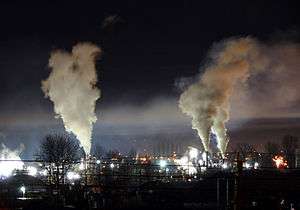Air pollution in Canada

Industry is a significant source of air pollution in Canada.
Air pollution in Canada is regulated by standards set by the Canadian Council of Ministers of the Environment (CCME), an inter-governmental body of federal, provincial and territorial Ministers responsible for the environment. The CCME has set Canada Wide Standards (CWS).[1][2] These are:
- CWS for PM2.5 = 30 µg/m3 (24-hour averaging time, by year 2010, based on 98th percentile ambient measurement annually, averaged over 3 consecutive years).
- CWS for ozone = 65 ppb (8-hour averaging time, by year 2010, achievement is based on the 4th highest measurement annually, averaged over 3 consecutive years).
Note that there is no consequence in Canada to not achieving these standards. In addition, these only apply to jurisdictions with populations greater than 100,000. Further, provinces and territories may set more stringent standards than those set by the CCME.
Air pollution by Province
British Columbia
See also
References
- ↑ "Canada-wide Standards". Archived from the original on 2004-07-06. Retrieved 2010-08-25.
- ↑ "Canada-Wide Standards for Particulate Matter (PM) and Ozone" (PDF). Archived from the original (PDF) on 2011-05-27. Retrieved 2010-08-25.
This article is issued from
Wikipedia.
The text is licensed under Creative Commons - Attribution - Sharealike.
Additional terms may apply for the media files.
.svg.png)